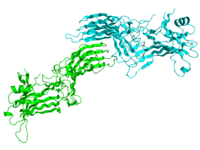
Photo from wikipedia
G protein–coupled receptors (GPCRs) are the largest family of cell surface receptors and signal through the proximal effectors, G proteins and β-arrestins, to influence nearly every biological process. The G… Click to show full abstract
G protein–coupled receptors (GPCRs) are the largest family of cell surface receptors and signal through the proximal effectors, G proteins and β-arrestins, to influence nearly every biological process. The G protein and β-arrestin signaling pathways have largely been considered separable; however, direct interactions between Gα proteins and β-arrestins have been described that appear to be part of a distinct GPCR signaling pathway. Within these complexes, Gαi/o, but not other Gα protein subtypes, directly interacts with β-arrestin, regardless of the canonical Gα protein that is coupled to the GPCR. Here, we report that the endogenous biased chemokine agonists of CXCR3 (CXCL9, CXCL10, and CXCL11), together with two small-molecule biased agonists, differentially formed Gαi:β-arrestin complexes. Formation of the Gαi:β-arrestin complexes did not correlate well with either G protein activation or β-arrestin recruitment. β-arrestin biosensors demonstrated that ligands that promoted Gαi:β-arrestin complex formation generated similar β-arrestin conformations. We also found that Gαi:β-arrestin complexes did not couple to the mitogen-activated protein kinase ERK, as is observed with other receptors such as the V2 vasopressin receptor, but did couple with the clathrin adaptor protein AP-2, which suggests context-dependent signaling by these complexes. These findings reinforce the notion that Gαi:β-arrestin complex formation is a distinct GPCR signaling pathway and enhance our understanding of the spectrum of biased agonism. Description Some chemokine receptor ligands induce the formation of a Gαi:β-arrestin complex that alters downstream signaling. A complex to complicate chemokine signaling G protein–coupled receptors (GPCRs) represent about 30% of the targets of FDA-approved drugs. GPCRs signal through two pathways that are considered separable: one dependent on direct activation of heterotrimeric G proteins and the other on the recruitment of β-arrestin proteins. Building on their previous work, Zheng et al. showed that some, but not all, of the endogenous agonists of the chemokine receptor CXCR3 induced the formation of a Gαi:β-arrestin complex, which was independent of the relative extent of activation of either G protein or β-arrestin signaling pathways. Signaling downstream of the Gαi:β-arrestin complex was different from that stimulated by β-arrestin alone. Together, these data add to the evidence of crosstalk between G proteins and β-arrestins and may have implications for the development of GPCR-targeting drugs.
Journal Title: Science Signaling
Year Published: 2022
Link to full text (if available)
Share on Social Media: Sign Up to like & get
recommendations!